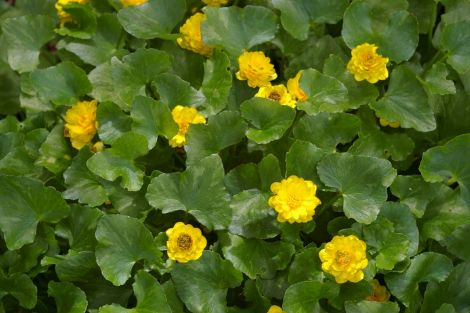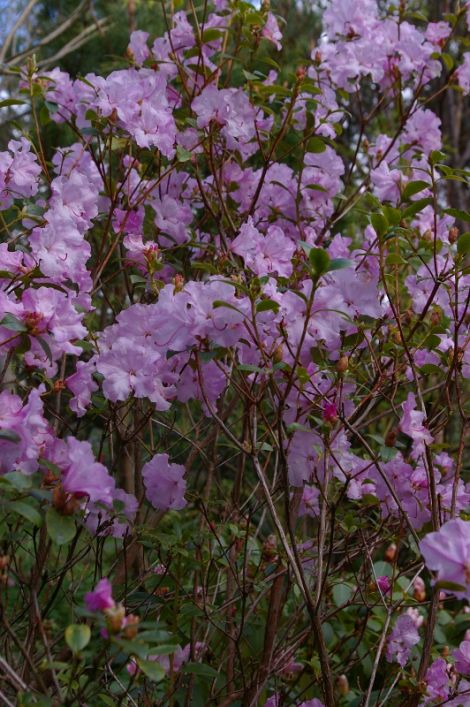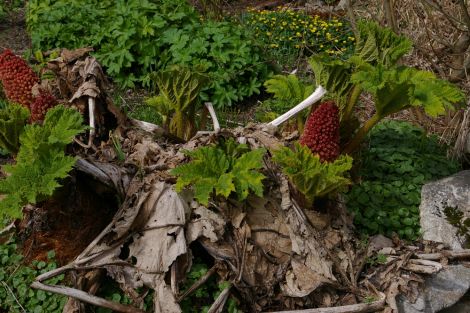Four Seasons / Four Seasons – Late Spring
There are a thousand things to catch up with
The name Ramsay is derived from ramsons, but I’ve yet to ascertain whether individuals bear that name because their ancestors lived near sources of, were growers, purveyors, or enthusiastic consumers of Allium ursinum, better known as wild or bear’s garlic.
It’s in vogue as a culinary herb at present, but a little caution is advised when picking it, as cases of poisoning have occurred when toxic autumn crocus or lily-of-the-valley leaves were harvested by mistake. While the eye can be deceived, the nose is a more reliable organ, as the whole plant has a distinct garlic scent.
Returning to Shetland in spring after a continental holiday can be a bit of a shock to the system, but last Wednesday the weather was kind, the sun was shining, and despite extreme tiredness I was out in the garden from the minute I turned off the car engine until the light failed.
Springs that started their gentle and slow progression in early March are a thing of the past. These days winter brown and grey suddenly gives way to tender green and there are a thousand things to catch up with, especially weeds.
Innocent looking green doilies of bittercress are in full flower and hell-bent on setting seed. During dry and breezy weather, freshly pulled weeds on the verge of reproduction can simply be left to shrivel and their limp remains removed to the compost heap the following day.
Many annual and ephemeral weeds have a knack of ripening their seeds, even if covered in layers of rotting vegetation, but help is at hand with Lea Gardens’ tried and tested fast composting method for “dangerous” weeds. Pack them as tightly as you can into black bags, sprinkle a generous dose of fresh sheep’s “pearls” amongst them and cook in the sun. Ready to use as an organic fertiliser within 4-6 weeks.
Become a member of Shetland News
Celandine can be extremely difficult to eradicate, but charms with its lacquered yellow cups above fresh green foliage. You can keep it in check by cutting it down before it gets a chance to seed. I have a soft spot for its numerous cultivars. The range includes creams and fiery coppers, doubles and semi-doubles, and plants with strikingly marked or chocolate brown foliage. They don’t seed much and vanish quietly in mid-summer, leaving the scene for later treasures.
Dandelion is one weed I wouldn’t want to be without. Its bitter leaves are great for ridding your body of its winter toxins and taste great in a salad, especially when combined with young sorrel – and a few rosettes of peppery bitter cress. The only dressing such a wild salad needs is a pinch of sugar, a squeeze of lemon and walnut or pumpkin seed oil.
Edibles are going to be thin on the ground at Lea Gardens this year. Marshalls seeds arrived in the post this morning but are probably going to languish in their box for some time to come.
With no helpers before June it’s either ornamentals or edibles, and I’ve decided to plump for the former. Even in a garden as well-established as mine there is always room for improvement and high time to find permanent homes for all those plants patiently and in all likelihood painfully waiting in containers way too small for them.
The garden is glorious with tender spring green and the floors of the woodland areas, as far as the eye can see, are carpeted with pale blue Scilla bithynica, trout lilies, white snakeshead fritillaries, late narcissi, wood anemones, cream-coloured tulips and sky blue lungwort.
Such expansive plantings don’t make themselves, but isolated clumps and patches rapidly become sheets of colour with the gardener’s help. Apart from the lungwort, which is best split in autumn, all the plants mentioned above can be gently lifted and carefully divided for immediate re-planting elsewhere during a spell of damp, calm weather.
The Lenten roses (Helleborus orientalis) are at their best now, Rhododendron praecox is wreathed in fresh lavender and the damp beds around the pond are slowly coming to life.
There, a great spectacle of nature can be observed every April, as the large crumpled leaves and red, conical inflorescences of Gunnera tinctoria break through the bleached protecting remains of last years growth. The plant is not reliably frost-hardy, and bending its leaves over the resting crown brings it safely through the harshest winter.
Eighteen months after ‘In the Garden’ vanished from the pages of the Shetland Times, bereft readers of my column still contact me and ask me to take up my pen again. Alas, this is not within my power.
And to quash all those rumours once and for all, the column did not stop because I was “fed up with writing it” or because I had “run out of ideas” or (perish the thought) I was prevented from putting fingers to keyboard because of some mysterious illness. ‘In the Garden’ was given its marching orders by Paul Riddell, the paper’s editor.
My blog “The Impossible Garden” was launched in March this year and you can find (almost) weekly updates on my garden and its many inhabitants by pasting www.leagardens.co.uk into your browser bar.
My Shetland Times column was my only steady form of income and its loss has pulled the rug of financial security from underneath Lea Gardens’ feet, but help might be at hand.
Ramsons abound in the White Garden, and are now served in posh restaurants the world over. Who knows, the trend might catch on in Shetland eateries and with some clever marketing I might be able “to put some butter on my parsnips” yet.
In the meantime, should you have a spare lettuce or a bunch of radishes (organically grown only), please throw them my way – in exchange for something the eye rather than the palate enjoys.
Rosa Steppanova
Become a member of Shetland News
Shetland News is asking its many readers to consider paying for membership to get additional features and services: -
- Remove non-local ads;
- Bookmark posts to read later;
- Exclusive curated weekly newsletter;
- Hide membership messages;
- Comments open for discussion.
If you appreciate what we do and feel strongly about impartial local journalism, then please become a member of Shetland News by either making a single payment, or setting up a monthly, quarterly or yearly subscription.





























































